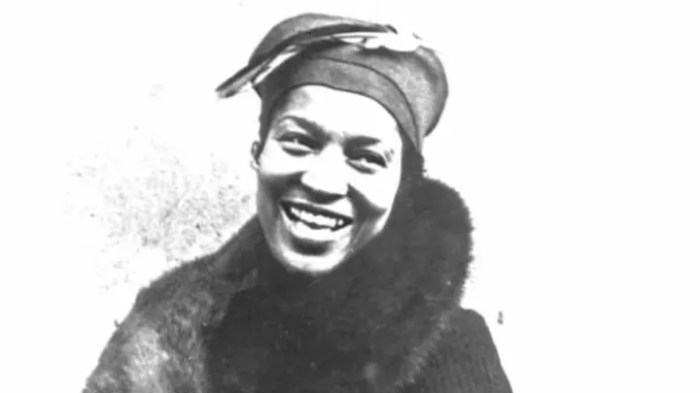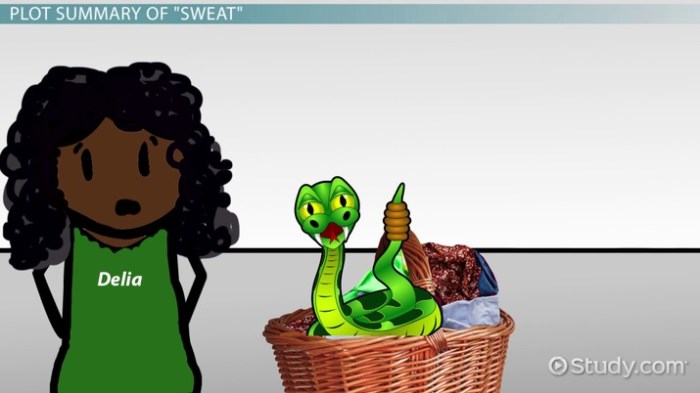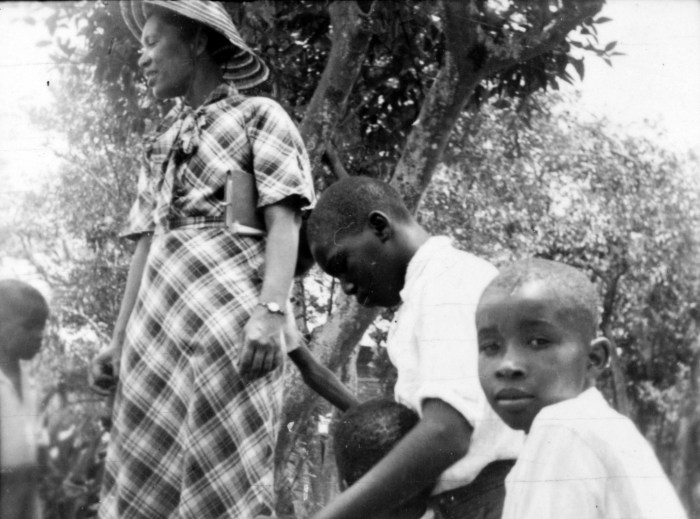Zora neale hurston sweat pdf – Prepare to delve into the captivating world of “Sweat” by Zora Neale Hurston, now available in a convenient PDF format. This literary masterpiece, set against the backdrop of the Harlem Renaissance and the Great Depression, offers a profound exploration of social and racial tensions, gender roles, and the indomitable spirit of African American women.
Brace yourself for an immersive reading experience that will leave a lasting impact.
Through the lens of a feminist perspective, we’ll dissect the portrayal of female characters and their struggles. We’ll examine the use of symbolism and imagery, such as the washerwoman’s sweat and the rocking chair, to unravel the story’s deeper meanings.
Get ready to engage in a thought-provoking analysis of narrative structure and style, as we delve into the author’s masterful use of language and dialect.
Literary Analysis of “Sweat” by Zora Neale Hurston

Zora Neale Hurston’s “Sweat” is a powerful and poignant short story that explores the complex lives of African Americans in the rural South during the early 20th century. The story’s title, “Sweat,” holds profound significance, as it encapsulates the physical and emotional labor that Delia Jones, the protagonist, endures throughout the narrative.
Delia’s relentless work as a washerwoman symbolizes the oppressive social and economic conditions faced by African Americans during this era. Her daily toil, characterized by sweat and exhaustion, reflects the arduous labor that many African Americans were forced to undertake in order to survive.
Through the washerwoman’s occupation, Hurston highlights the systemic racism and economic exploitation that marginalized African Americans during this period.
Character Analysis of Delia Jones
Delia Jones emerges as a multifaceted and resilient character in “Sweat.” Despite the hardships she faces, she possesses an unwavering determination and strength. Delia’s resilience is evident in her ability to withstand the oppressive conditions of her life, including her abusive husband and the prejudice she encounters in her community.
However, Delia’s character is not without its flaws. Her intense pride and stubbornness sometimes lead her to make rash decisions. Additionally, her inability to fully express her emotions and vulnerability contributes to her isolation and the ultimate tragedy that befalls her.
Historical Context and Cultural Impact

Zora Neale Hurston’s “Sweat” emerged during a pivotal era in American history, shaped by the Harlem Renaissance and the Great Depression. These events profoundly influenced the story’s themes and its enduring relevance.
Harlem Renaissance and Racial Tensions
The Harlem Renaissance was a vibrant cultural movement that celebrated African American art, literature, and music. However, despite its cultural significance, the era was also marked by persistent racial tensions and discrimination.
Zora Neale Hurston’s Sweat PDF provides a powerful glimpse into the complexities of race and gender in the American South. For further insights into the struggles faced by marginalized communities, consider reading An Indian Father’s Plea PDF , which explores the challenges faced by Native Americans.
Returning to Hurston’s Sweat PDF, its vivid portrayal of the protagonist’s resilience in the face of adversity remains a testament to the indomitable spirit of those who have been marginalized.
- Hurston’s story reflects these tensions through the characters of Delia and Sykes Jones, whose relationship is strained by power dynamics and racial inequality.
- Delia’s struggle for autonomy and respect in the face of Sykes’s oppressive behavior highlights the challenges faced by African American women during this time.
Great Depression and Economic Hardship
The Great Depression brought widespread economic hardship, which disproportionately affected African Americans.
- In “Sweat,” the Joneses’ financial struggles symbolize the economic challenges faced by many African Americans during this era.
- Sykes’s inability to provide for his family and Delia’s determination to maintain their home reflect the resilience and adaptability of African American communities in the face of adversity.
Enduring Legacy and Contemporary Relevance
“Sweat” continues to resonate with readers today due to its exploration of timeless themes such as power dynamics, racial inequality, and economic hardship.
- The story remains relevant in contemporary discussions about gender equality, racial justice, and the impact of economic inequality on marginalized communities.
- Delia Jones has become an iconic figure, representing the strength and resilience of African American women.
Feminist Perspectives and Gender Roles
Zora Neale Hurston’s “Sweat” offers a nuanced exploration of gender roles and expectations through its portrayal of female characters and their struggles. The story challenges traditional gender stereotypes, subverting some while reinforcing others, revealing the complex and multifaceted nature of gender in the early 20th century.
The story’s central character, Delia Jones, embodies both traditional and non-traditional gender roles. As a hardworking and independent woman, she defies the expectation that women should be subservient to men. She earns her own living, manages her household, and stands up for herself against her abusive husband, Sykes.
Gender Roles and Expectations
- Delia challenges the traditional gender role of women as passive and dependent. She is assertive, outspoken, and determined to maintain her independence.
- Sykes, on the other hand, embodies traditional masculine stereotypes. He is physically strong, dominant, and possessive. He expects Delia to be submissive and obedient, and he uses violence to control her.
- The story also explores the gendered division of labor. Delia is responsible for domestic chores, while Sykes is expected to provide for the family financially. However, Sykes shirks his responsibilities, leaving Delia to bear the burden of both work and housework.
Subversion of Gender Stereotypes
Hurston subverts traditional gender stereotypes by presenting Delia as a strong and capable woman who refuses to be defined by her gender. She is not afraid to stand up to Sykes and defend herself, even though she knows she is physically weaker than him.
Delia’s strength and resilience challenge the notion that women are inherently weak and submissive. She demonstrates that women are capable of great strength and determination, even in the face of adversity.
Reinforcement of Gender Stereotypes
Despite its subversion of some gender stereotypes, the story also reinforces others. Sykes’s violent and controlling behavior towards Delia reflects the widespread acceptance of domestic violence against women in the early 20th century.
Additionally, the story’s focus on Delia’s domestic responsibilities reinforces the traditional view of women as primarily responsible for the home and family. While Delia’s strength and independence are admirable, the story ultimately suggests that women’s primary role is still within the domestic sphere.
Symbolism and Imagery

Zora Neale Hurston employs a rich tapestry of symbolism and imagery in “Sweat” to convey the oppressive and suffocating atmosphere of Delia’s life. These elements serve as potent metaphors for the protagonist’s struggles, enhancing the story’s emotional depth and impact.
The Washerwoman’s Sweat
Delia’s relentless labor as a washerwoman is symbolized by her constant sweat. This physical exertion mirrors her emotional turmoil and the weight of her responsibilities. The sweat stains on her clothing become a tangible representation of her exhaustion and the relentless nature of her work.
Hurston uses sensory details to vividly convey the oppressive heat and humidity that accompany Delia’s toil. The “thick, hot air” and “sweat-soaked clothes” create an immersive experience for the reader, highlighting the physical and emotional toll of Delia’s daily routine.
The House
Delia’s house is a symbol of her dreams and aspirations. It represents her desire for a better life, a sanctuary away from the harsh realities of her daily existence. However, the house remains unfinished, its walls bare and its roof leaking, reflecting Delia’s unfulfilled hopes.
The broken windows and sagging porch further emphasize the dilapidated state of the house, symbolizing Delia’s own broken spirit and the challenges she faces. The house serves as a constant reminder of her unmet expectations and the obstacles that stand in her way.
The Rocking Chair
The rocking chair in Delia’s house is a poignant symbol of her longing for comfort and stability. It is a place where she can escape the chaos and hardship of her life, even if only for a moment. However, the rocking chair is also a reminder of her isolation and loneliness.
Hurston’s description of the chair as “lonesome” and “empty” evokes a sense of longing and unfulfillment. The rocking chair becomes a symbol of Delia’s unfulfilled desires and the void that remains in her life despite her efforts to create a home.
Narrative Structure and Style: Zora Neale Hurston Sweat Pdf

Zora Neale Hurston’s “Sweat” is a masterfully crafted short story that employs a complex narrative structure and a distinct use of language and dialect to create a powerful and immersive reading experience.
The story is structured around a central conflict between Delia Jones and her husband Sykes, a conflict that unfolds through a series of flashbacks and foreshadowing.
Flashback
Hurston uses flashbacks to reveal the events leading up to the present conflict. These flashbacks provide insights into Delia’s past experiences and the reasons for her present actions. For example, the flashback to Delia’s encounter with Sykes at the store reveals the origins of their strained relationship.
Foreshadowing
Hurston also employs foreshadowing to create a sense of anticipation and dread. The story’s opening line, “Sweat ran down her face,” foreshadows the emotional and physical turmoil that Delia will endure throughout the story.
Language and Dialect
Hurston’s use of language and dialect is essential to the story’s authenticity and impact. The characters’ dialogue is written in a vernacular that reflects the speech patterns of rural African Americans in the early 20th century. This use of dialect helps to create a sense of place and time, and it also allows the characters to express themselves in their own unique voices.
Pacing and Rhythm, Zora neale hurston sweat pdf
The story’s pacing and rhythm contribute to the sense of suspense and tension. The story begins with a slow, deliberate pace that builds to a crescendo of violence and chaos. This pacing creates a sense of anticipation and dread, as the reader is drawn into the escalating conflict between Delia and Sykes.
FAQ Compilation
Is “Sweat” available in other formats besides PDF?
Yes, “Sweat” is also available in print, ebook, and audiobook formats.
What is the significance of the washerwoman’s occupation in the story?
The washerwoman’s occupation symbolizes the undervalued and often overlooked labor of African American women during the time period in which the story is set.
How does “Sweat” reflect the social and racial tensions of the Harlem Renaissance?
The story portrays the complex social and racial dynamics of the Harlem Renaissance, highlighting the challenges faced by African Americans in a society marked by segregation and discrimination.
